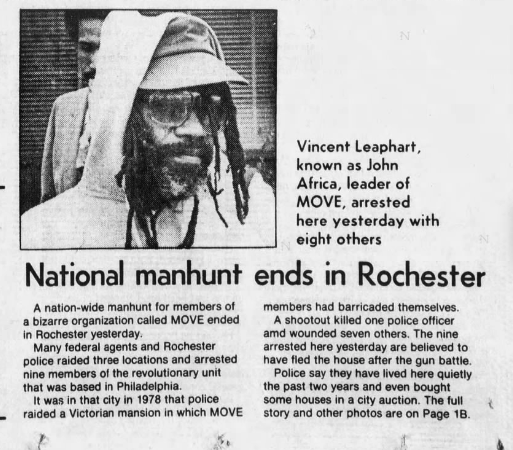Today marks 39 years since the MOVE bombing in Philadelphia. What was Rochester's connection?
Today marks 39 years since Philadelphia police bombed the MOVE home, which left 11 members of the Black Liberation group dead, 61 homes destroyed, and over 250 people homeless.
Between the lives that were lost and the mass destruction in West Philadelphia, the anniversary of this horrific event shines light on a connection to Rochester.
What is MOVE?
The MOVE organization started in 1972 amid turbulent relations between Philadelphia police and the city's Black residents.
The group was a political and religious organization with anti-government, anti-technology, and anti-corporation values. It was known for its non-violent but disruptive protests at zoos, pet stores, and political rallies.
Its members lived communally and described themselves as a family, all taking the last name 'Africa.'
The Philadelphia community at the time had mixed feelings about the MOVE organization. Some sympathized with their views and missions, while others found them disruptive and militant.
Four years after a 1978 confrontation with Philadelphia Police, the group moved to a rowhouse on Osage Avenue in West Philadelphia. Many community members complained about the disruptive activity and trash around the home, leading to Mayor Wilson Goode ordering their eviction.
What happened on May 13, 1985?
On May 13, 1985, Philadelphia police dropped a bomb made of C-4 explosive materials on the MOVE rowhouse, aiming to neutralize an alleged bunker on the roof of the home after efforts to evict the organization failed and led to a standoff and shootout. The city approved the usage of the bomb despite knowing children were inside.
Officials let the blazing fire from the bomb burn out of control for over an hour as West Philadelphia residents watched their neighborhood engulfed by flames.
Rochester's connection: Who was John Africa?
John Africa, born Vincent Lopez Leaphart on July 26, 1931, was the creator and founder of the MOVE organization. He was a West Philadelphia native and Korean War veteran. His ideologies were prided on Black revolutionary ideas, animal rights, and a back-to-nature movement, though his beliefs and ideals have become somewhat contradictory.
He glorified peace and the beauty of nature, vigorously pushing back against modern civilization and technology while simultaneously leading a group that stowed handguns and explosives.
In September 1977, 10 MOVE members headed by Leaphart were indicted by a Philadelphia grand jury for conspiracy, unlawful possession, and manufacturing of explosive devices. When federal agents went to serve the arrest warrants, John Africa had disappeared.
Less than a year later, in August 1978, a failed blockade and negotiations at the MOVE's barricaded compound on North 33rd Street erupted into violence. Police removed 12 adult MOVE members from the compound, yet John Africa remained elusive.
That's because he was hiding out in Rochester, NY.

On May 13, 1981- exactly four years before the MOVE rowhouse bombing, nine MOVE members, including Africa, were arrested in Rochester. A report in the Democrat and Chronicle on May 14, 1981, says the nine members were believed to have fled to Rochester after the 1978 shootout and subsequently bought houses in a city auction.
Officials didn't specify how they knew Africa was hiding out in Rochester, but they said the MOVE affiliates had been in town for two years.
During their investigation, police observed members going to work at Sears, Roebuck & Co. and buying groceries at the Public Market.
John Africa informed authorities MOVE was a non-violent group but emphasized they wouldn't passively await death. He was arrested on federal conspiracy and weapons charges but ultimately acquitted after representing himself, leaving the prosecution stunned.
Four years later, Africa was sighted for the last time as his charred body was removed from the MOVE rowhouse on a stretcher on May 13, 1985.
The Aftermath
There were only two survivors of the bombing, Romona Africa, then 29, and Birdie Africa, then 13, who later became known as Michael Moses Ward.
There were two grand jury investigations and a civil lawsuit into the MOVE rowhouse bombing, yet to this day, no one has been criminally charged.
The incident has become known as one of the worst tragedies in American history.
— Madison Scott is a journalist with the Democrat and Chronicle who edited our Weld Street Project and also did reporting for it. She has an interest in how the system helps or doesn't help families with missing loved ones. She can be reached at MDScott@gannett.com.
This article originally appeared on Rochester Democrat and Chronicle: MOVE bombing in Philadelphia: What was Rochester NY connection?
